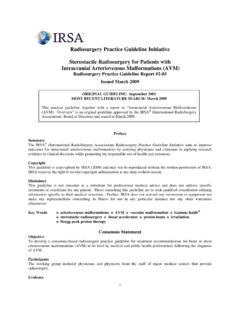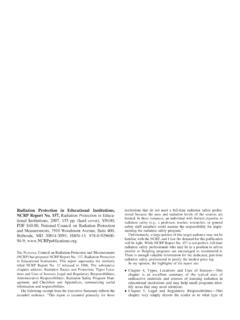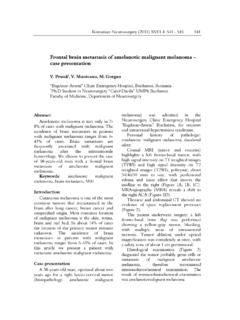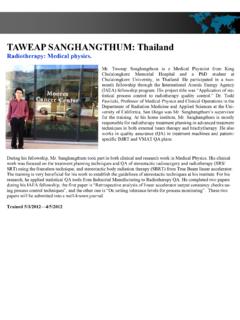Transcription of Radiosurgery Practice Guideline Initiative …
1 1 Radiosurgery Practice Guideline InitiativeStereotactic Radiosurgery for Patients withRadiosurgery Practice Guideline Report #4-06 Vestibular SchwannomasVestibular SchwannomasVestibular SchwannomasORIGINAL Guideline : May 2006 MOST RECENT LITERATURE SEARCH: March 2006 This Practice Guideline , together with a report on Vestibular Schwannoma Management is an original Guideline approved by the IRSA (International Radiosurgery Association)Board of Directors and issued in May IRSA (International Radiosurgery Association) Radiosurgery Practice Guideline Initiative aims to improve outcomesfor vestibular schwannoma Radiosurgery by assisting physicians and clinicians in applying research evidence to clinicaldecisions while promoting the responsible use of health care Guideline is copyrighted by IRSA (2006)
2 And may not be reproduced without the written permission of IRSA. IRSA reserves the right to revoke copyright authorization at any time without Guideline is not intended as a substitute for professional medical advice and does not address specific procedures orconditions for any patient. Those consulting this Guideline are to seek qualified consultation utilizing informationspecific to their medical situation. Further, IRSA does not warrant any instrument or equipment nor make anyrepresentations concerning its fitness for use in any particular instance nor any other warranties WORDS vestibular schwannomas acoustic tumor acoustic neuroma stereotactic Radiosurgery Gamma Knife linear accelerator proton beam image guided robotic irradiationConsensus StatementObjectiveTo develop a consensus-based Radiosurgery practiceguideline for vestibular schwannoma management to beused by medical and public health working group included physicians from the staff ofmajor medical centers that provide
3 First authors (AN/LDL) conducted a literature searchin conjunction with the preparation of this document anddevelopment of other clinical guidelines . The literatureidentified was reviewed and opinions were sought fromexperts in the diagnosis and management of vestibularschwannoma, including members of the working ProcessThe initial draft of the consensus statement was a synthesisof research information obtained in the evidencegathering process. Members of the working groupprovided formal written comments that were incorporatedinto the preliminary draft of the statement. No significantdisagreements existed.
4 The final statement incorporatesall relevant evidence obtained by the literature search inconjunction with final consensus recommendationssupported by all working group CompositionThe Radiosurgery guidelines Committee is comprised ofneurosurgeons, neurotologists, and radiation physician specialties are incorporated of Group Members: L. Dade Lunsford, ,Neurosurgeon, Chair; Ajay Niranjan, , ,Neurosurgeon; Georg Nor n, , Neurosurgeon; JayLoeffler, , Radiation Oncologist; Alain de Lotbini re, , Neurosurgeon; Jordan Grabel, , Neurosurgeon;Douglas Kondziolka, , Neurosurgeon; Jean R gis, , Neurosurgeon; Pierre-Hughes Roche, ,Neurosurgeon; Robert Smee, , Radiation Oncologist;Burton Speiser, , Radiation Oncologist; Mark Alden, , Radiation Oncologist; Sandra Vermeulen, ,Radiation Oncologist; William F.
5 Regine, ,Radiation Oncologist; Barry Hirsch, , Neurotologist;Tonya K. Ledbetter, , , Editor; Rebecca , , , , ex recommendations are made regarding targetpopulation, treatment alternatives, interventions andpractices and additional research needs. Appropriate useof Radiosurgery for patients with vestibular schwannomais Guideline is intended to provide the scientificfoundation and initial framework for the person who hasbeen diagnosed with a vestibular schwannoma. Theassessment and recommendations provided hereinrepresent the best professional judgment of the workinggroup at this time, based on research data and expertisecurrently available.
6 The conclusions andrecommendations will be regularly reassessed as newinformation becomes RadiosurgeryIntracranial stereotactic Radiosurgery involves the use ofprecisely directed closed skull single session radiationto create a desired radiobiologic response within theintracranial target with minimal effects to surroundingstructures or tissues. In the case of vestibular schwannoma,highly conformal, precisely focused radiation is deliveredto the acoustic tumor in a single session under the directsupervision of a Radiosurgery team. At Centers ofExcellence, the Radiosurgery team includes aneurosurgeon, a radiation oncologist, a physicist and aregistered nurse.
7 In some centers, a neurotologist is alsoa member of the primary Schwannoma: Overview andSurgical ManagementBackgroundVestibular schwannoma (also known as acoustic neuroma,acoustic neurilemoma, or acoustic neurinoma) is a slow-growing, intracranial extra-axial benign tumor thatusually develops from the balance (vestibular) nerve orvery rarely from the hearing (cochlear) nerve, supplyingthe inner ear. The tumor originates from anoverproduction of Schwann cells, which normally wraparound nerve fibers to support and insulate nerves. Asthe tumor grows, it presses against the hearing andbalance nerves, usually causing unilateral hearing loss,tinnitus (ringing in the ear) and tumor growth can interfere with the trigeminalnerve, resulting in facial numbness.
8 A vestibularschwannoma can also press on the facial nerve givingrise to facial weakness and/or twitching. As these tumorsincrease in size, they eventually occupy a large portionof the cerebellopontine angle. If the tumor continues togrow, it will eventually press against the brainstem andthe cerebellum, and will become life threatening or causeblockage of cerebrospinal fluid flow, a condition knownas vestibular schwannomas affect only one account for approximately 8% of all tumors insidethe skull; one out of every 100,000 individuals per yeardevelops a vestibular Symptoms maydevelop at any age but usually occur between the ages of30 and 60 years.
9 Unilateral vestibular schwannomas arenot considered to be hereditary. Both males and femalesare equally affected by the vestibular schwannomas affect both hearingnerves and are usually associated with a genetic disordercalled neurofibromatosis 2 (NF2). Half of affectedindividuals inherit the disorder from an affected parentand half seem to be the first in their family to have a genemutation. Each child of an affected parent has a 50%chance of inheriting the disorder. Bilateral vestibularschwannomas are a principal clinical feature ofneurofibromatosis 2, although other manifestations,including peripheral neurofibromata, meningioma,glioma, and juvenile posterior subcapsular lens opacities,are often present as well.
10 Spinal cord tumors, mainlyependymomas, frequently affect the patient. Two distinctphenotypes can be described, one severe (Wishartphenotype) and one mild (Gardner phenotype),corresponding respectively to distinct modifications ofthe gene and of distinct prognostic value. Most patientswith NF2 present in late adolescence or early vast majority of vestibular schwannomas developfrom the Schwann cell covering of the vestibular portionof the vestibulocochlear The superior and inferiorvestibular nerves appear to be the nerves of origin withabout equal frequency. Very rarely schwannomas (lessthan 5%) arise from the cochlear portion of thevestibulocochlear nerve.






